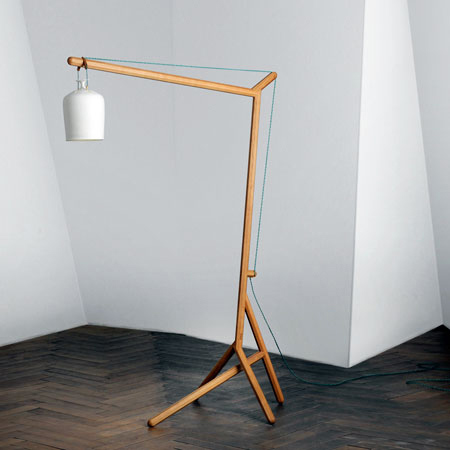
Furniture by Postfossil
Milan 09: Swiss design collective Postfossil present a range of lighting and furniture in the SaloneSatellite at Salone Internazionale del Mobile this week.
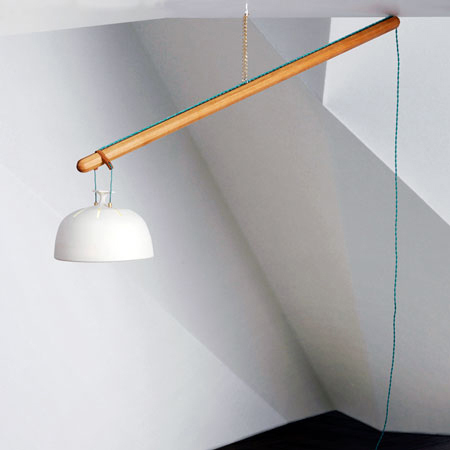
The designers created the collection in order to contemplate the role of design "in a post-fossil age". Captions are provided by the designers.
Above: Standing and Pendant lights, Sabooh and Mitsu by Anna Blattert and Daniel Gafner
The lamps Sabooh and Mitsu are showing that energy saving LED technology can also be used in the home. Inspired by oriental lanterns, the translucent porcelain shades give off a warm, indirect light. The golden decoration on the inside of the shade serves as a reflector, as well as a conductor from cable to bulb. The base of the standing lamp with its octagonal profile, made of durable oak, holds the shade in the correct position thanks to its outstretched arm. The pendant light is surprising in its simplicity. The ceiling serves as a point of support for the boom. By slightly pulling the hanging cable the shade can be swung through 360°. The shades Sabooh and Mitsu are hung over the stand and the boom like lanterns and can be easily exchanged with each other and hung or lay in any other position. The rather flat shade Mitsu radiates light more widely and is ideal as a hanging light over a dining table or as general room light. The high shade Sabooh throws the light more directly and is therefore especially well suited as a reading light.
Materials:
Shade: porcelain with gold application
Base: oak
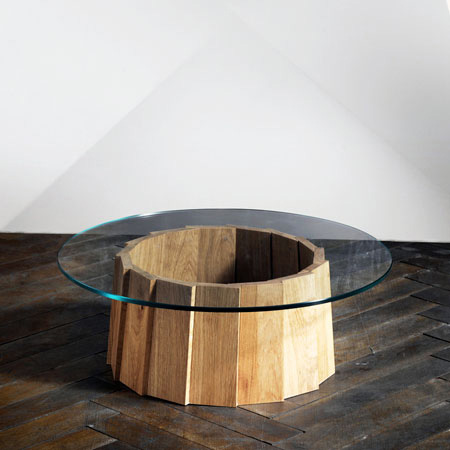
Above: Charcoal pile table by Thomas Walde
Oiled oak pieces in a circle form the base of this simple living room glass table, held together without glue due to the «wood welding» process used in its production. Its shape is reminiscent of charcoal burning and symbolises a charcoal pile where pieces of wood are stacked conically around a stake. The work takes as its central theme this precursor of oil and stimulates thinking about the future.
Materials: Oak, glass
Size: 25x70cm
Partner: bfh-ahb Bern University of Applied Sciences, Wood technology, Biel www.ahb.bfh.ch
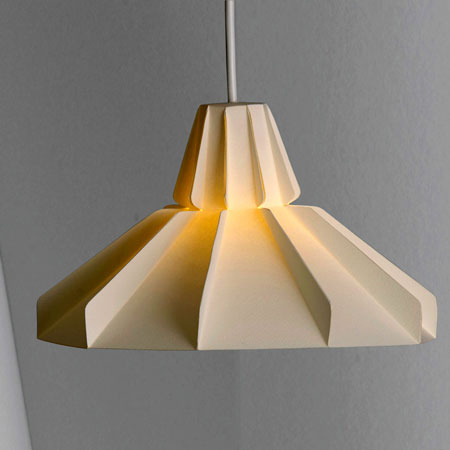
Above: Loppa (envelope) by Florian Hauswirth
A postfossil lamp, inspired by envelopes
The lamp surrounds a bulb like an envelope encloses a letter. The material (paper) is folded into a robust structure. The flaps are folded upwards, one side moistened before both are joined together. These connecting ribs give the filigree lampshade its stability. Paper reflects the light, but also allows it to shines through slightly. An energy saving bulb is used as illumination. This type of bulb, which will soon become standard in the future, generates a beneficially lower amount of heat. Its original flat shape allows easy transport.
Material: Paper, natural glue
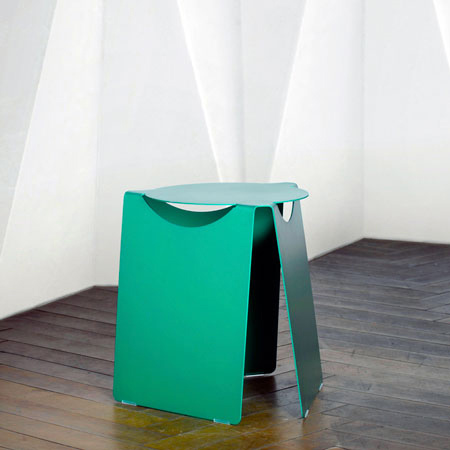
Above: Plymet stool by Florian Hauswirth
A stool folded by hand
A stool or side table easily folded into shape from a flat form. The cut form, with holes at the ends of the slits, allows it to be bent in a controlled manner. The trianular shape of the stool gives it its stabilty. When folded, the narrow slits act as handles.
Material: anodised aluminium
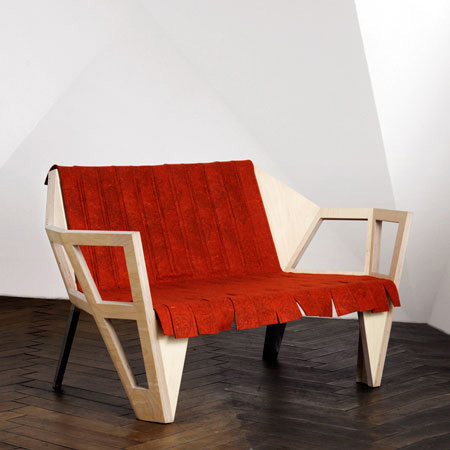
Above: BIVANO – seat for two by Claudia Heiniger
The couch Bivano is a solution for all those people who don’t dispose of a lot of space in their apartments since it uses very little material and space. The frame is made of multilayer boards. The individual pieces can be taken from only one board in an efficient way and this allows to reduce the consumption of material already in the cutting phase. The stringing with elastic belts creates a very comfortable albeit materially reduced seating space, which adapts slightly to the body when seated. The printed felt belts allegorically stand for the cushioning which is completely absent in Bivano. The conscious use of material and the corresponding design are an answer to the post fossil era. Whilst seated on Bivano you can comfortably talk about the current times.
Materials
Frame: plywood, iron
Covering: elastic straps, wool felt
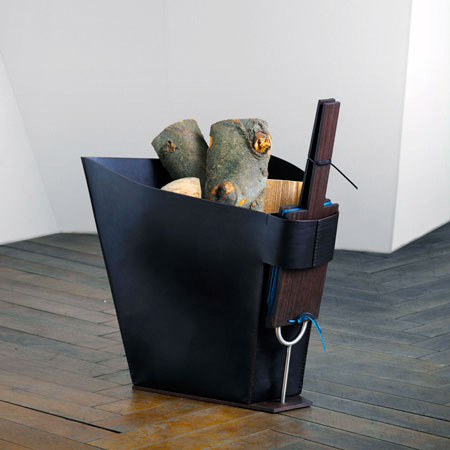
Above: Fireside companion set Souffleur Ramón by Christine Birkhoven
The fireside companion set Souffleur Ramón comprises a bellows and a firewood basket, both of wood and leather.
A bellows is not only a beautiful object with a homely character, but also a reflection of the energy needed to kindle a fire. It invites one to take time to make a really good fire that produces a good heat. Bellows have long been disappearing into obscurity, either because of modern heating technology or because today there are supposedly quicker methods of ignition (such as firelighters). However, firelighters are often unhealthy and environmentally unfriendly. This new design breathes new life into the bellows and shows that Souffleur Ramón is not only a more attractive way to kindle a fire, but is also environmentally friendly and saves resources.
Materials: wenge wood, leather, and stainless steel.
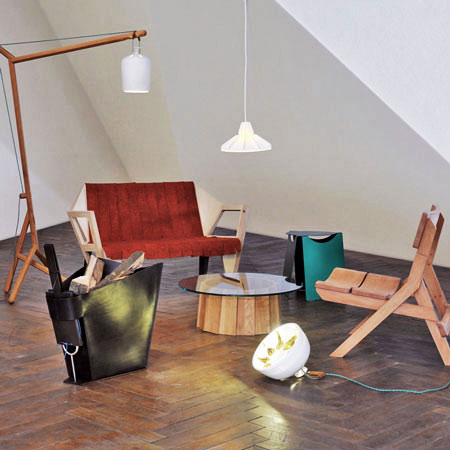
Above: JWC - Just Wood Chair by Florian Hauswirth (seen above right)
A chair made only of wood
This chair consists exclusively of wood, without glue. The joints are made with a new wood-joining technique, the ‘rotation dowel welding’ technique. The heat generated by placing the dowels releases adhesives present in the wood itself – lignin and hemicellulose – forming a substantial welded bond in seconds. In association with Sebastian Kraft from the Biel School for Wood Technology (BFH –AHB) this new kind of chair was produced. The chair was designed with the technique in mind. The overlaps required for the welded bonds and the wing-like construction are characteristic features of the ‘JWC’ lounge chair.
Material: 100% beechwood = 100% Postfossil
Photographs by Miriam Graf.
See all our stories from Milan in our special MIlan 2009
Here's more information from Postfossil:
--
2009, the POSTFOSSIL design platform already at the SaloneSatellite in Milan for a second time: What will the concern of future design be? Design that raises questions.
April 2009
Following their successful appearance at the SaloneSatellite at the Milan furniture fair last year, the designers of the POSTFOSSIL platform will again be exhibiting in Milan. A central theme is the question of design’s purpose in a post- fossil age. With this in mind, the designers will be discussing the subject of the SaloneSatellite: Designing Wellness. They have created furniture and living accessories that feature unexpected product solutions.
The Postfossil platform was established in 2007 by young designers in Switzerland who work in various areas of product and furniture design alongside their involvement in the platform. The platform offers the designers space to exchange ideas without boundaries and to consider together what the focus of design will be in the future. With their products, the designers of the POSTFOSSIL platform intend to influence their environment and strengthen the relationship between user and object, against the backdrop of post-fossil thinking.
With its enquiry, the POSTFOSSIL platform has opened up an important issue. This was demonstrated by the receipt of the Designreport Award 08 for the First Light lamp at last year’s SaloneSatellite, and the Swiss bronzener Hase award for Die Besten. The exhibitions in Milan and in Norway at the ‘a world of folk’ in Stavanger generated discussion and were well received by international design magazines. Their products were also publicised in the book Desire (published by Gestalten) and in “Limited Edition” by Sophie Lovell.
Two new articles by POSTFOSSIL at the beginning of the year show how relevant the topic is today. In connection with the ‘Fluxus & Dada im Cabaret Voltaire’ exhibition in Zurich, POSTFOSSIL developed les boites de l’avenir. Reminiscent of the boxes of the Fluxus movement, they deal with future scenarios of a post-fossil age. POSTFOSSIL was also able to exhibit in Switzerland at the ‘Crash the Oil’ series of events in the Kunstraum exhibition space at Corner College, Zurich.
Careful handling of resources has additional significance in current times. Alternative possibilities for sustainable use of materials and resources are being discussed. The furniture and living accessories by POSTFOSSIL presented in Milan reflect this discussion while at the same time showing that these kinds of solutions do not mean limitations in product design. Much more than this, the designers want to draw attention with their objects to a lifestyle of greater awareness, which will also have a long -term effect on the user’s well being.
This year too, the POSTFOSSIL designers are exhibiting objects in Milan which feature carefully worked solutions both from a formal perspective as well as in relation to the material used. The furniture and living accessories reflect each varying aspect of a post-fossil age.
It will be exciting to follow the POSTFOSSIL platform’s appearance at the SaloneSatellite this year.
The POSTFOSSIL platform at the SaloneSatellite 2009:
22. – 27. April 2009 / SaloneSatellite, Milan / Pavilion 28 / Stand B24
Members of the POSTFOSSIL platform 2009 in Milan:
- Anna Blattert
- Christine Birkhoven
- Claudia Heiniger
- Daniel Gafner
- Florian Hauswirth
- Thomas Walde